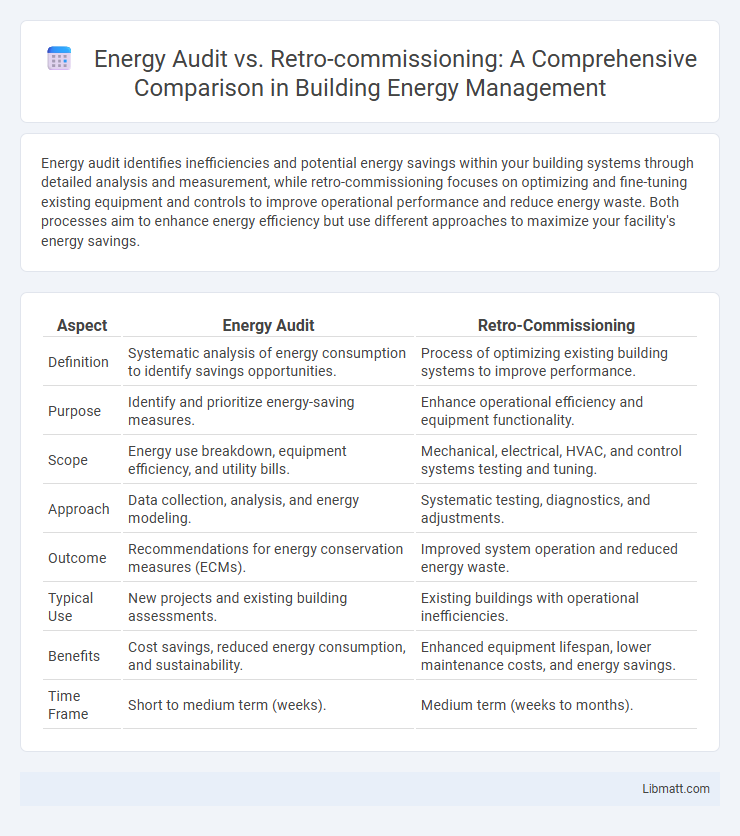Energy audit identifies inefficiencies and potential energy savings within your building systems through detailed analysis and measurement, while retro-commissioning focuses on optimizing and fine-tuning existing equipment and controls to improve operational performance and reduce energy waste. Both processes aim to enhance energy efficiency but use different approaches to maximize your facility's energy savings.
Table of Comparison
| Aspect | Energy Audit | Retro-Commissioning |
|---|---|---|
| Definition | Systematic analysis of energy consumption to identify savings opportunities. | Process of optimizing existing building systems to improve performance. |
| Purpose | Identify and prioritize energy-saving measures. | Enhance operational efficiency and equipment functionality. |
| Scope | Energy use breakdown, equipment efficiency, and utility bills. | Mechanical, electrical, HVAC, and control systems testing and tuning. |
| Approach | Data collection, analysis, and energy modeling. | Systematic testing, diagnostics, and adjustments. |
| Outcome | Recommendations for energy conservation measures (ECMs). | Improved system operation and reduced energy waste. |
| Typical Use | New projects and existing building assessments. | Existing buildings with operational inefficiencies. |
| Benefits | Cost savings, reduced energy consumption, and sustainability. | Enhanced equipment lifespan, lower maintenance costs, and energy savings. |
| Time Frame | Short to medium term (weeks). | Medium term (weeks to months). |
Introduction to Energy Audit and Retro-Commissioning
Energy audits systematically assess building energy use to identify inefficiencies and recommend cost-effective improvements; they analyze consumption patterns, equipment performance, and operational practices. Retro-commissioning focuses on optimizing existing building systems to ensure they function as originally intended, improving HVAC and lighting operations without major equipment replacements. You can leverage energy audits for broad efficiency insights and retro-commissioning for fine-tuning building performance and reducing unnecessary energy consumption.
Defining Energy Audit: Purpose and Process
An energy audit is a systematic evaluation of a building's energy consumption aimed at identifying inefficiencies and recommending cost-effective strategies for energy savings. It involves data collection, analysis of utility bills, on-site inspections, and identification of opportunities for reducing energy use and operational costs. The primary purpose is to provide actionable insights and a roadmap for improving energy performance and sustainability.
Understanding Retro-Commissioning: Scope and Benefits
Retro-commissioning focuses on optimizing existing building systems to improve energy efficiency, occupant comfort, and operational performance by identifying and correcting inefficiencies in HVAC, lighting, and controls. It involves systematic testing and tuning of equipment to ensure systems operate as intended without major upgrades or replacements. Your building can benefit from reduced energy costs, extended equipment lifespan, and enhanced indoor environment quality through this cost-effective process.
Key Differences Between Energy Audit and Retro-Commissioning
Energy audits analyze a building's overall energy consumption to identify cost-saving opportunities, while retro-commissioning focuses on optimizing existing systems for improved operational efficiency. Energy audits provide a broad assessment including usage patterns and equipment performance, whereas retro-commissioning systematically tests and calibrates HVAC, lighting, and control systems to enhance functionality. Key differences include the scope and methodology: energy audits are diagnostic and strategic, whereas retro-commissioning is technical and hands-on, targeting immediate performance improvements.
When to Choose an Energy Audit
Energy audits are essential when a building owner seeks to identify specific energy-saving opportunities through a comprehensive evaluation of existing systems and practices. Choose an energy audit during new acquisitions, after significant equipment upgrades, or when detailed cost-benefit analysis is required for energy conservation measures. This process provides actionable insights for reducing energy consumption, improving efficiency, and planning capital investments effectively.
When Retro-Commissioning is the Right Solution
Retro-commissioning is the right solution when existing building systems are underperforming or when energy audits identify operational inefficiencies without major equipment replacements. It focuses on optimizing and tuning current HVAC, lighting, and control systems to improve energy efficiency and occupant comfort. Unlike energy audits that highlight potential upgrades, retro-commissioning implements corrective measures to enhance system performance and reduce energy consumption.
Common Goals and Overlapping Areas
Energy audits and retro-commissioning share common goals of improving energy efficiency, reducing operational costs, and enhancing building performance. Both processes involve detailed assessments of building systems, identifying inefficiencies in HVAC, lighting, and controls to optimize energy use. Overlapping areas include analyzing equipment functionality, verifying system integration, and recommending corrective measures to ensure optimal energy consumption and occupant comfort.
Cost and ROI Comparison: Energy Audit vs. Retro-Commissioning
Energy audits typically have lower upfront costs ranging from $0.10 to $0.50 per square foot, with an average ROI of 10% to 30% through energy savings and operational improvements. Retro-commissioning involves higher initial investments, often between $0.30 and $1.00 per square foot, but yields greater ROI potential of 15% to 40% by optimizing existing building systems and correcting inefficiencies. Choosing between the two depends on budget constraints and the facility's age, with retro-commissioning offering more substantial long-term savings for older, underperforming buildings.
Real-World Case Studies and Success Stories
Energy audits identify inefficiencies and recommend improvements, exemplified by a New York commercial building reducing energy consumption by 25% following targeted HVAC and lighting upgrades. Retro-commissioning optimizes existing systems without major equipment replacement, as shown in a California office complex that boosted energy savings by 15% through recalibrating and fine-tuning its HVAC controls. Both methods have proven effective in real-world applications, with documented case studies highlighting substantial operational cost reductions and enhanced occupant comfort.
Conclusion: Selecting the Best Approach for Your Facility
Energy audits identify inefficiencies and provide actionable recommendations to improve energy performance through equipment upgrades and behavioral changes. Retro-commissioning focuses on optimizing existing building systems to ensure they operate as originally intended, often enhancing operational efficiency without major equipment replacement. Your choice depends on whether the goal is to uncover potential energy-saving opportunities through system upgrades or to improve the efficiency of current operations by fine-tuning existing controls.
Energy audit vs Retro-commissioning Infographic

 libmatt.com
libmatt.com